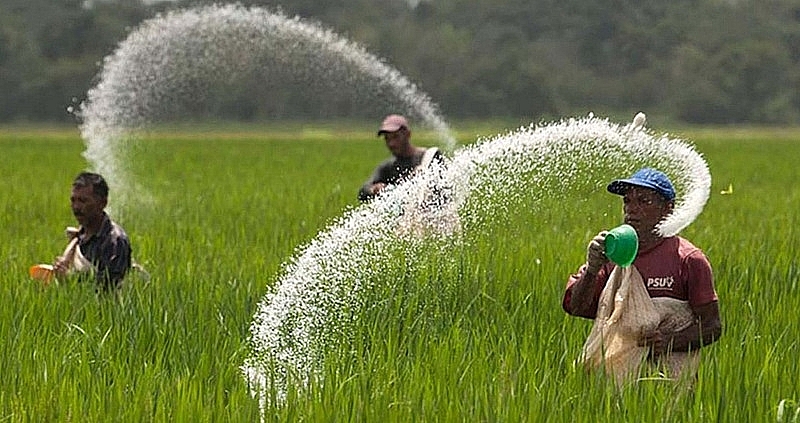VAT reform promotes sustainable development of the agricultural sector
In the revised Draft Law on Value Added Tax (VAT), the conversion of fertilizers and specialized machinery and equipment serving agricultural production to applying 5% VAT since it belongs to the group of subjects not subject to tax according to current law, it is a content that receives attention from the business community, especially fertilizer production enterprises. According to experts and businesses, converting this item to a taxable object will have a huge impact on agricultural production.
 |
|
There are many very specific benefits when applying 5% VAT to the fertilizer industry. Source: Internet. |
Most countries apply VAT on fertilizers
To promote the development of the agricultural industry, support farmers in reducing production costs, remove difficulties, create conditions for the domestic fertilizer production industry to develop sustainably, and at the same time achieve the goal of narrowing the target audience. Not subject to VAT, recently, businesses and the Vietnam Fertilizer Association have repeatedly proposed amending Tax Law 71/2014/QH13 to include fertilizers subject to VAT.
According to Mr. Nguyen Van Phung, former Director of the Large Enterprise Tax Management Department (General Department of Taxation), not imposing VAT has created many difficulties for businesses and farmers over the years. Domestic fertilizer producers are not allowed to deduct input VAT for raw materials, machinery and services, leading to high product prices. This not only increases fertilizer prices for farmers but also causes domestic fertilizer enterprises to lose their competitive advantage compared to imported goods that are subject to VAT deduction in the country of origin. According to Mr. Phung, there are many very specific benefits when applying 5% VAT to the fertilizer industry.
Accordingly, the imposition of a 5% VAT helps increase budget revenue for import taxes while still maintaining the domestic selling price level. For farmers, they have the opportunity to request businesses to sell at new lower prices, request fertilizer businesses to comply with the law, and to deduct inputs, they need to lower the selling price level. Besides, we are moving towards a green economy and a circular economy. Currently, there are many large enterprises investing in rural areas. The imposition of VAT helps fertilizer businesses to deduct input VAT declarations.
Sharing more about this issue, Mr. Nguyen Tri Ngoc, Vice Chairman of the Vietnam Fertilizer Association, said that most countries in the world apply VAT on fertilizers. For example, China applies a low tax rate of 11%, Russia 20%, Thailand and Malaysia also apply VAT on fertilizers. With the draft VAT Law (amended) providing that fertilizer products are subject to 5% VAT, fertilizer industry enterprises will see many prospects. Accordingly, businesses can use the refunded tax money to invest in machinery, improve technology, improve fertilizer quality and bring better products to farmers, helping to shorten a lot of time and money for farmers.
The biggest goal is to bring greater efficiency to the economy
From a business perspective, according to Mr. Nguyen Hoang Trung, Deputy General Director of DAP-Vinachem Joint Stock Company, practical experience and data over the past 10 years show enough to evaluate the results when implementing no VAT on fertilizers. Due to not being subject to VAT, all input costs must be included in production costs. Every year, about 7-8% of production costs increase because of this regulation, an estimated loss of about 100 billion VND each year, 10 This year, the cumulative figure is up to thousands of billions of dong. Mr. Trung said that production costs have increased, but market prices cannot be adjusted because there is unfair competition between domestically produced and imported goods. Therefore, adjusting the VAT policy on fertilizers from non-taxable to 5% taxable is the right and necessary step in the current context. This is not only a solution to overcome difficulties for domestic fertilizer production enterprises, but also a measure to support farmers, reduce agricultural product prices and promote the sustainable development of Vietnam's agricultural industry.
Mr. Nguyen Hoang Trung affirmed that the VAT regulations on fertilizers have been amended to impose a tax of 5%, which has many benefits. First of all, input tax costs can be reduced, leading to lower prices and increased competitiveness in the market. This opportunity helps the domestic fertilizer production industry compete better with imported fertilizers and wants to dominate the market, increase market share, thereby adjusting selling prices and increasing after-sales service for farmer.
In addition, businesses will have resources and motivation to increase investment, reinvest, upgrade and repair machinery and equipment, and expand production scale. This is a very important premise for the domestic fertilizer production industry. For many years, businesses have not been able to innovate technology due to tax law procedures, leading to lack of economic efficiency, so they cannot innovate. This opportunity will create more motivation for technological innovation in the domestic manufacturing industry. Increasing investment in improving product quality also creates conditions for farmers to use better quality fertilizers.
Agreeing with the draft Law's proposal to include fertilizers in the subject of 5% VAT, expert Nguyen Van Phung also proposed that on this occasion the drafting agency should review other industries, for example animal feed production industry, machinery and equipment manufacturing industry for agriculture and rural development... According to Mr. Phung, which quantified items are included in the taxable or non-taxable regulations and calculated? to the interconnected relationship between industries on the basis of ensuring the rights of the state, businesses and consumers and ultimately bringing greater efficiency to the economy.








